Welcome to Madagascar! A representative will welcome you at the international arrival hall. Please look out for a sign with your name after you exit the restricted area with your luggage. Transfer to your hotel.
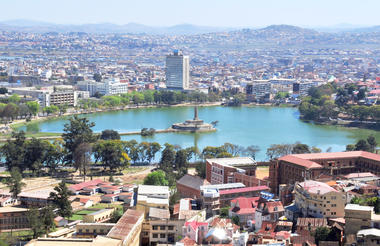
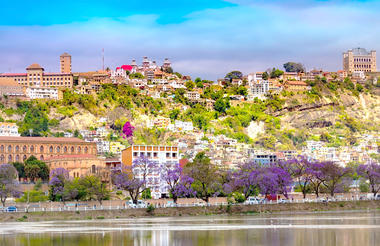
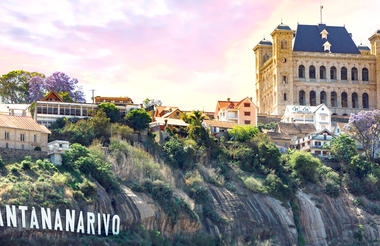
We transfer you to the domestic terminal so you can take your private charter flight to Morondava. A member of our team will pick you up at the domestic arrivals hall. Once your luggage collected, you will then be led to your vehicle for your private transfer.
Betania village: Early in the morning and depending on the time of the tide, we embark on a pirogue and we pass through the port of Botry ( traditional dhows ) and navigate across the mangroves. We arrive at Betania, a small coastal village of Vezo fishermen. The Vezo is the term the semi-nomadic coastal people of southern Madagascar who are fishermen. They go as far as 50km away from the shores on their small pirogues without any navigation instruments. We will see them arriving from their fishing trip. As soon as the pirogues are emptied, we watch the locals bargain for the freshest catch of the day, picking out fresh shrimps, mackerels, tuna and sharks.



We start our journey on the dusty roads of Madagascar’s Midwest with dry deciduous forest, small villages, river crossings on barges. We will reach Belo sur Tsiribihina for a lunch stop and then drive to Bekopaka, the gateway to the Tsingy. This is a 100-mile journey which will last about 8 hours.
The Baobab Alley: The Avenue or Alley of the Baobabs is a prominent group of baobab trees lining the dirt road between Morondava and Belo sur Tsiribihina in the Menabe region in western Madagascar. Its striking landscape draws travelers from around the world, making it one of the most visited locations in the region. It has been a center of local conservation efforts, and was granted temporary protected status in July 2007 by the Ministry of Environment, Water and Forests, the first step toward making it Madagascar's first natural monument.
Along the Avenue there are 20 - 25 trees about 50 feet in height, of the species Adansonia grandidieri, endemic to Madagascar. Some 20 - 25 more trees of this species grow in nearby rice paddies and meadows. Baobab trees, up to 800 years old, known locally as renala (Malagasy for "mother of the forest"), are a legacy of the dense tropical forests that once thrived on Madagascar. The trees did not originally tower in isolation over the sere landscape of scrub but stood in dense forest. Over the years, as the country's population grew, the forests were cleared for agriculture, leaving only the baobab trees, which the locals preserved as much in respect as for their value as a food source and building material. The area is not a national park, and the trees are threatened by further deforestation, effluent from encroaching rice paddies and sugarcane plantations, and bush and forest fires. Despite its popularity as a tourist destination, the area has no visitor center or gate fees, and local residents receive little income from tourism.



Great Tsingy visit: We embark on our 4x4 vehicle and drive to entrance of the trail, about 10 miles north of Bekopaka. We will be equipped with harnesses clipped to the steel cable to climb and walk across the lime stone forest. The beautiful Tsingy de Bemaraha Integral Nature Reserve is home to rare or eminently remarkable geological phenomena, including karstic scenery with a highly dissected limestone massif rising up to 100 yards, forming veritable cathedrals and offering a grandiose, spectacular natural landscape.



Manambolo river ride: At dawn, we take a traditional pirogue ( dugout ) to navigate on the Manambolo river and admire the impressive gorges (canyons). Further up on the river, we will see some caves and learn about the funeral traditions of the Vazimba (the first inhabitants of Madagascar).
Small Tsingy: We start with an introduction to the Tsingy of Bemaraha. The short circuit passes through a labyrinth of limestones via walkways and iron ladders and small bridges. While the pinnacles were steep, they are not too high. We can observe them over from two view points. We have some good chances to spot the Decken’s sifaka and red-fronted brown lemurs.
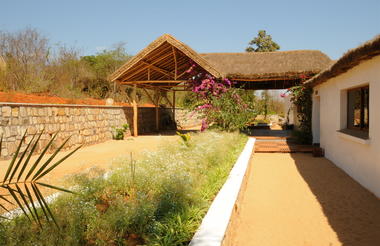
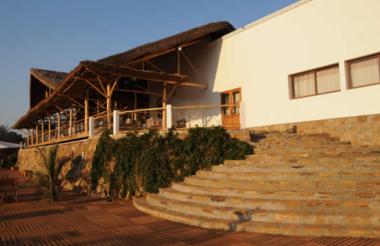
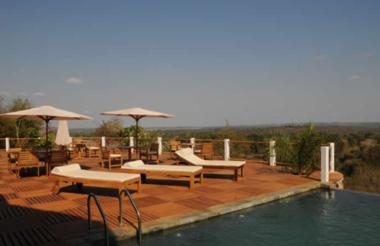
Early in the morning, we line up our 4X4 at the Manambolo river in order to be among the first to cross on the barge. We drive the road towards Belo sur Tsiribihina which we will reach before lunch.



We transfer you to the private charter terminal so you can embark on your private charter flight to Ranohira, the gateway to the the Isalo massif. This is a two-hour flight. A member of our team will pick you up at the domestic arrivals hall. Once your luggage is collected, you will then be led to your vehicle for your private transfer to the hotel.
Zombitse-Vohibasia National Park: We will visit the Zombitse-Vohibasia National Park, which constitutes the most important remnant of dry deciduous forest of Madagascar. Zombitse-Vohibasia acts as a transition zone between the dry and the humid forests of Madagascar. Therefore the flora is especially rich within the protected area. Baobabs and several orchids are particularly common. The number of animal species living here is also remarkable. 15 small mammals, 2 carnivorous and 8 lemur species, such as the Verraux´s sifaka, red-fronted brown lemur, ring-tailed lemur, pale fork-marked lemur and the Hubbard´s sportive lemur can be observed here. Birds are also a park highlight. There are 85 species, most of them endemic like the rare Appert´s greenbul, which only lives in this forest. 33 reptile and 8 amphibian species have been reported in Zombitse, such as the Standing´s day gecko, which is also local endemic to the Park.
Four different short and easy circuits (from one to five hours walk) are offered by the park authorities in order to allow visitors to discover the richness and diversity of this last natural refuge.
Isalo window: At the end of day, we drive to the window of Isalo, a rectangular formation of rocks atop a hill with a large hole, hence a window. This natural picture frame is the perfect setting for a photo of the beautiful Madagascar sunsets.
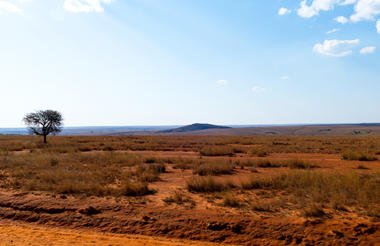


Isalo National Park: Accompanied by your park ranger, we will hike through the canyons and oases of Isalo and its lunar landscape to reach some waterfalls. This environment was formed during the Jurassic age and where the unique flora has evolved adapting to the existing conditions. There are 77 species of birds live in Isalo among which the rare and famous Benson rock-thrush (Pseudocossyphus bensoni). During that hike, we will see different species of lemurs, including the world-famous ring tailed lemur. After the canyons, we will go to different places to see a panoramic view of the landscape. We will have the opportunity to relax in this environment and swim in the natural pools.

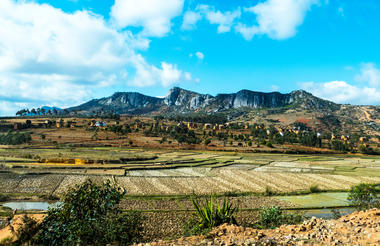

Transfer to Anakao: The safest and fastest way to reach Anakao, 28 miles south from Tulear, is by speedboat. Anakao is not an island. A huge river, Onilahy, blocks the path at the level of Saint Agustin. Before 9:30am at the port, we embark on a powerful speed boat which will take us comfortably in less than one hour to Anakao.
After going along Sarodrano’s sand bank and leaving the lagoon, the route crosses the Tropic of Capricorn at the mouth of the “Onilahy” river. This is where you can see whales (June to September), dolphins and flying fish. Finally, you will go along the coast between Soalara and Anakao, seaside or lagoon side, depending on the tides. Our skilled skipper will drop you off right in front your hotel on Anakao’s beach.



Nosy Ve: We sail to Nosy Ve, a small half-mile long inhabited island. It is a sacred place for people of Anakao. The crossing takes less than 1 hour to go depending on the winds. The island is one of the few places in the world known as a place of reproduction of red-tailed tropicbird (Phaethon rubricauda). We can observe adults nesting with baby birds. This island is also a good snorkeling spot and has an amazing beach. For once in your life, you may feel like you are Robinson Crusoe. We return to Anakao early afternoon before the wind gets too gusty.



Transfer to Toliara: The return trip to Toliara from Anakao usually leaves early, no later than 7:30am. We go through the reverse route. The boat will pick you up in front of your hotel.
Upon arriving in Toliara, one of our drivers will wait for you at the port. Once your luggages collected, you will then be led to your vehicle for your private transfer. We transfer you to the domestic terminal for your Air Madagascar flight to Tana. A member of our team will pick you up at the domestic arrivals hall for your private transfer to the city.
Antananarivo, Old City and Upper Town: We will visit the Old city and upper town of Antananarivo. The majestic Rova ( The Queen’s palace ) overlooks the capital from the highest point of the city. The Rova of Antananarivo is a royal palace complex that served as the home of the sovereigns of the Kingdom of Imerina in the 17th and 18th centuries, as well as of the rulers of the Kingdom of Madagascar in the 19th century. The historic boroughs around the Rova (The Queen’s palace) have nice panoramic views of downtown. You will drive or walk the neighborhood with your guide to enjoy the picturesque ambiance of the noblemen residence area, with both well-kept traditional houses, the colonial houses, palaces, cathedrals, the charm of the narrow, curved, upslope cobblestoned streets and ensemble of cute traditional Malagasy houses built entirely of wood. This whole package make the unforgettable ambiance of this borough.
Enjoy a beautiful sundowner with a spectacular vista over the city of Antanananarivo. You will served some wine and local delicacies.
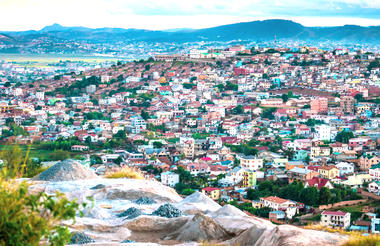
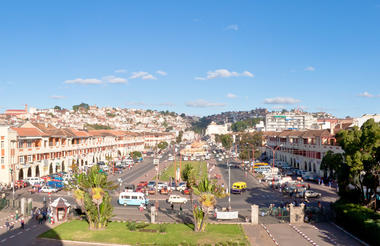
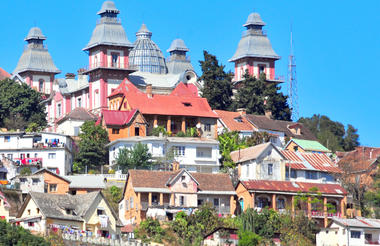
We start our journey towards the Eastern part of the island. After exiting the busy and colorful city of Antananarivo, we reach the Route Nationale 2, the main commercial road of the country which leads to the East coast of Madagascar and its main harbor. During our 93-mile (3.5-hour) journey, we will see various landscapes of the highlands from small traditional villages perched on hill sides, rice fields. A twisty, steep and lush portion of the road will announce that we are entering another region of Madagascar. You will arrive in Andasibe, known for its National Park, home of the primary and secondary forest. The Peyrieras Butterfly Farm: We will make a stop at Madagascar Exotic. This private reserve is also known as the Peyrieras Butterfly Farm, or Peyrieras Nature Farm or Mandraka Reptile Farm. It is a small privately run reserve (or zoo) at Marozevo. It was founded and owned by the French entomologist and naturalist André Peyriéras, which is why it is also known as the Reserve Peyrieras. The collection includes many reptiles (chameleons, iguanas, geckos, frogs), Batraciens (Bats), crocodiles, papillons (Butterflies). The adjacent forest area supports families of relocated and habituated Verreaux's Sifaka and Common brown lemur which provide opportunities to photograph them close up at feeding times.
Night walk in the VOIMMA reserve: At nightfall, pick up your headlamps and flashlights for a nocturnal walk in the rainforest. In 2012, villagers from Andasibe founded the reserve as an alternative to the nearby governmental led national park. For reptiles and amphibian lovers, the reserve offers countless frogs along its crystal clear river (among them Boophis pyrrhus, Boophis viridis and madagascariensis) and several amazing chameleons (Furcifer wilsii, Calumma parsonii cristifer, Calumma nasuta and brevicornis) in the forest. This is also a place to find the unique satanic leaf-tailed gecko (Uroplatus phantasticus). Bizarre insects like the famous giraffe necked weevil (Trachelophorus giraffae) are part of the forest, too. This community-run reserve is open for night-walks to those interested to search for lemurs, listen to the frogs, or stumble across sleeping chameleons after dark.
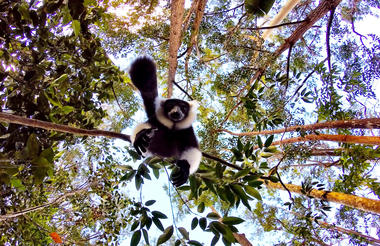
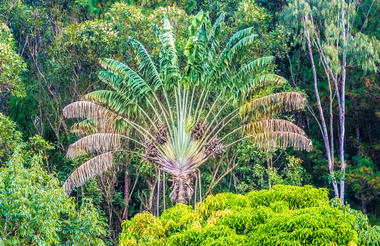
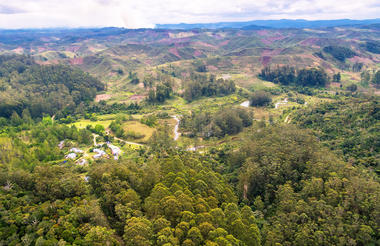
The Analamazaotra special reserve: In order to have the best observation conditions, we leave our hotel around 7:30am to reach the entrance of the Analamazaotra special reserve. We will look for biggest lemur of Madagascar's famous "Indri Indri." This lemur is endemic to the site and made his emblem. Through an easy hike lasting about 2 to 3 hours, we will search for groups of Indri Indri. We also find other species of lemurs, birds, chameleons, etc., as of endemic flora among other orchids, medicinal plants.
Vakona reserve visit: On the immense Vakona property, an island surrounded by fresh water is home to various species of lemurs: common brown lemurs, bamboo lemurs, ruffed lemurs, diademed sifakas. This will be a rare opportunity to get up close and interact with these primates. Amazing photo opportunities and souvenirs will be the result of that visit. The numerous crocodiles, which used to belong to a former farm, can also be found in one of the small lake of the property. If you happen to be around on a Saturday, you may see the reptiles having their weekly feast.
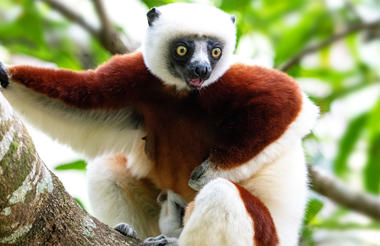

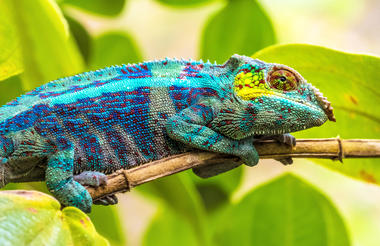
We now enter the Betsimisaraka region of Madagascar. The landscape vegetation now contrasts from the one we see in the highlands, the territory of the Merina tribe. The Betsimisaraka tribe have a different culture and this translate in different architectures of the houses and type of crops they grow.
After the 3-hour drive on a paved road, they will have a 30 minutes of dirt road to reach the lake Rasoabe, one of the great lakes of Madagascar. These great lakes were linked by man-made channels to form an inland waterway called the Canal of Pangalanes.
We board a speed boat on the Canal des Pangalanes for about an hour to head to the Palmarium. This is a 375-mile long channel; which is been used both as a means of transportation up and down the coast and as a fishing area.
The canal still dominates daily life in this region as it provides the main source of trade, transport and travel. Cruising by boat on the calm waters of Pangalanes is a fascinating journey through time and history. Many traditional Betsimisaraka villages can be seen along the banks, as well as pirogues (traditional dugout canoes), local fishermen, over-crowded ferries and rafts with straw huts carrying timber en-route to Tamatave.
Aye-aye Island visit: By the end of the afternoon, you will embark on the pirogue for a quiet ride on the Pangalane's Chanel which will pick you to the island of the famous Aye-Aye. Near the hotel, some six Aye-Aye individuals live in freedom. You will spend about an hour to explore the area and ride back to the hotel afterwards.


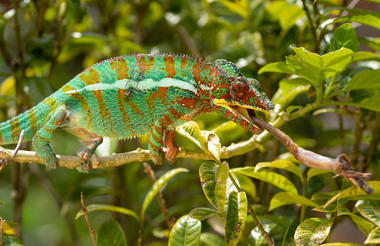
At the agreed time, we leave Ankanin'ny Nofy by boat to Manambato where the car will pick us up.
We continue the trip and begin our ascent towards the highlands and the capital. This journey will give you an impressive perspective about the difference of altitude between the two regions. This elevation is exploited by the hydroelectric power station which you will drive by. You will arrive in Antananarivo after almost 200-mile journey lasting about 5 hours.
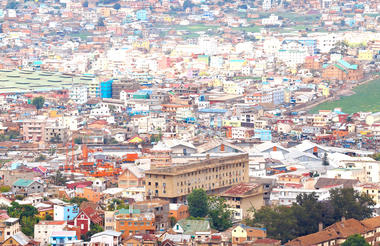
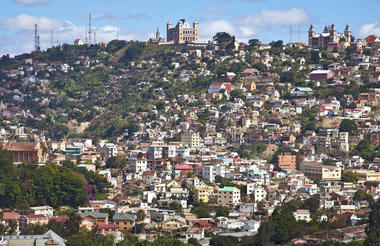
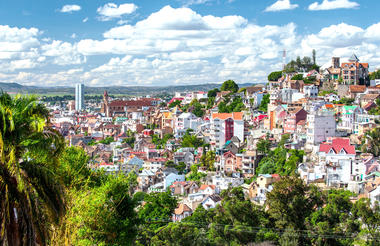
Antananarivo, CBD and downtown visit: Discover the city's main commercial and administrative neighborhoods, which spread out from the city's railroad station at Soarano, the Avenue of Independence and the place where the ‘Zoma’ (Friday market), the largest open air market in the world, takes place. You will have the opportunity to climb one of the many stairways called ‘totobato” which will lead you to the CBD , the street of jewelers and the Presidential Palace.
Handcrafts Markets of Antananarivo: Depending on what you are looking for to bring home, we will take you to the appropriate market. Among them, The Marche artisanal Digue is considered as the biggest market local handicrafts in Antananarivo. This bustling market sells everything from embroidery items to wood carvings. You can also find creations made of smooth leather and a special paper called ‘Antaimoro paper.’ Apart from the handicrafts, the Digue also offers semi-precious items like colored stones and home decor creations made from rare silks. We transfer you to the international terminal for your outbound flight.
END OF SERVICES.






